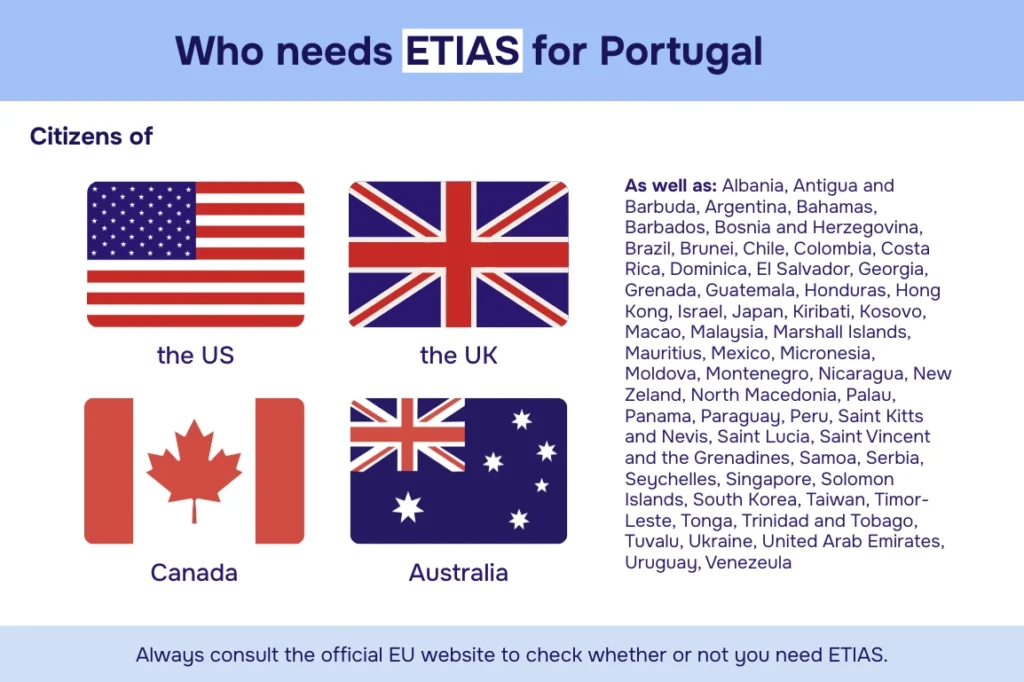Home > Applying for ETIAS for Portugal in 2026: What to Know
Applying for ETIAS for Portugal in 2026: What to Know
From its sunny beaches and enviable seafood to its famous cities, such as Lisbon and Porto, Portugal attracts millions of travelers every year.
If you’re one of the lucky people who get to plan a trip to Portugal, it can be confusing to understand which travel requirements apply to you, which don’t, and how to make sure you’re authorized and ready for travel. We’re here to help.
In this article, we will walk you through everything you need to know about ETIAS and how it applies to your upcoming trip to Lisbon, Faro, or wherever your Portuguese adventure takes you!

Is ETIAS required for Portugal?
Yes, from 2026 on, if you do not have a valid visa, you will need ETIAS to visit Portugal (note: Citizens/residents of Schengen countries do not need ETIAS).
The new ETIAS requirement applies to citizens from the US, Canada, UK, Australia, and others.
For context, the Schengen area has visa-waiver agreements with these countries, as well as others. This agreement allows passport holders from these countries to enter the Schengen area without having to obtain a visa to do so.
Portugal is part of the Schengen area.

Instead of a visa, citizens from visa-waiver countries will need to get pre-travel authorization to travel to Portugal
This authorization is called ETIAS. It’s important to understand that ETIAS isn’t a visa – it’s approval to enter the area. If you’re hoping to stay in the Schengen area for longer than 90 days, you will still need to apply for the appropriate Portuguese visa.
On the other hand, if you're not from a visa-exempt country (this applies to citizens of India, China, and more), you do not need ETIAS to travel to Portugal.
Instead, you need to apply for a Schengen visa.
Citizens of Schengen countries do not need ETIAS to travel to Portugal.
Do I need ETIAS if I have a Portugal visa?
No. If you hold a valid visa for Portugal (or Schengen visa), you do not need to apply for ETIAS. You can think of it as a “one or the other” situation.
To learn how to apply for a Portuguese visa or what the requirements are, check out our Portugal visa guide.

How to apply for ETIAS for Portugal
Once launched, applying for an ETIAS for your trip to Portugal should only take 10-20 minutes and will be done entirely online.
You’ll need to have a few things on hand, including your travel plans (such as destinations and dates), your passport, and a credit or debit card.
How to get ETIAS for Portugal
Step one: Fill out the form on the official ETIAS site
You’ll need to fill in details such as your name, passport number, and nationality. You’ll also need to provide your travel details.
Step two: Answer a few questions about your background.
According to the official European Union website, you’ll be asked to share your parents’ first names, current occupation, and level of education. You’ll also be asked about any past criminal convictions.
Step three: Pay the ETIAS fee
There is an application fee when applying for ETIAS authorization. You can expect to pay 20 euros. This fee is waived for travelers under the age of 18 or over the age of 70.
Step four: Wait for approval
In most cases, ETIAS approval is granted in just a few minutes. However, it can take up to 30 business days, so it’s best to plan accordingly and secure your ETIAS well ahead of time.
Step five: Travel to Portugal!
Once your ETIAS is approved, you are now authorized to enter the Schengen area! Congratulations. ETIAS authorization is automatically linked to your passport once you’re approved.
This means that authorities can see your approval when they scan your passport at the border. It never hurts to save a digital copy or even print out your approval, though, just in case.
Heading to sunny Portugal?
Protect your trip with bestselling insurance, 100% online.
ETIAS duration
Your ETIAS is valid for up to three years or until your passport expires, whichever comes first. To reapply, simply follow the steps above again.
ETIAS rejections
If your ETIAS is denied, you’ll receive an email outlining the reason(s) for refusal, as well as steps you can take to appeal the decision. Keep in mind that you won’t be able to travel to Portugal without ETIAS approval.
Traveling with your ETIAS
According to the EU website, a valid ETIAS does permit you to travel throughout the Schengen area and Cyprus.
With that being said, it does not guarantee entry. Border guards can still deny you entry.